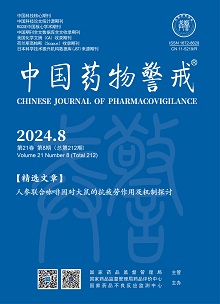|
|
Adverse reaction/event reports of esmolol
ZHAO Jun, DONG li, WANG Yang, LIANG Yu, YANG Xue, LI Enze
2024, 21(8):
925-930.
DOI: 10.19803/j.1672-8629.20240020
Objective To analyze the characteristics of esmolol-related adverse reactions/events so as to provide reference for safe drug use. Methods Case reports of esmolol-induced adverse reactions/events that were published between the inception and October 31, 2023 were retrieved from Web of Science, Pubmed, Springer Link, CNKI, Wanfang and VIP database. The consistency was verified by FAERS database between 2004 and 2023. Results A total of fourteen pieces of literature were included, involving fourteen patients who reported esmolol-related adverse reactions/events. These patients ranged in age from 15 to 94, with an average age of 59.79 years. The onset could take a few minutes or 9 days. The adverse reactions/events included seizures, delirium, hyponatremia, cardiac arrest, severe ventricular arrhythmia, and coronary artery spasm. A total of 208 patients with esmolol adverse events were detected in the FAERS database, with a total of 559 adverse events, involving 21 systematic organ classifications (SOCs). The signal was the strongest in case of junctional ectopic tachycardia, followed by decreased stroke volume, pulseless electrical activity, extravasation, heat attack, ventricular dysfunction, ventricular fibrillation, infusion site exudation, cardiogenic shock and coronary artery spasm, which was highly consistent with the case reports collected in literature. Conclusion Esmolol has been widely used in clinic, and most of the adverse reactions/events have been mild and transient. However, there are adverse reactions/events that are serious and left unmentioned in specifications. It is recommended that esmolol be used with caution, requiring early judgement of adverse effects, prompt discontinuation of the drug, and early administration of relevant symptomatic treatments.
References |
Related Articles |
Metrics
|
